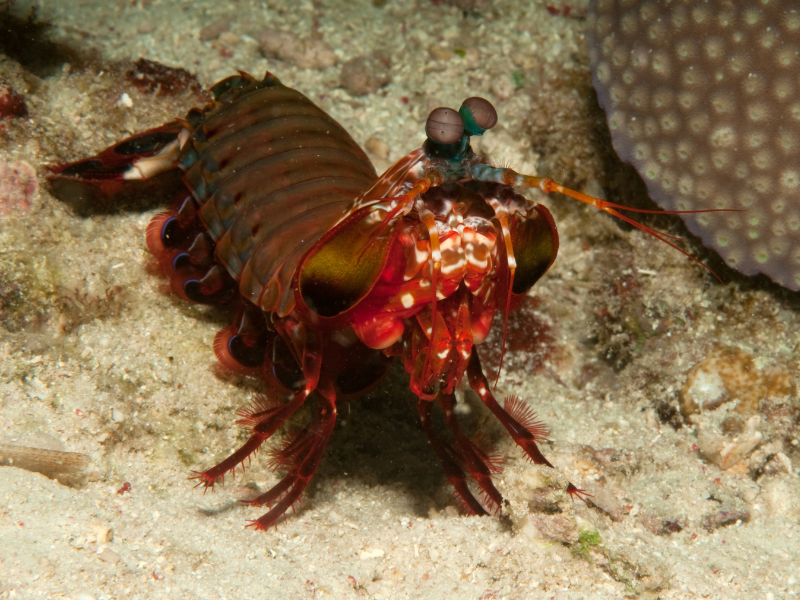Odontodactylus scyllarus
Peacock Mantis Shrimp

Scientific Classification
Quick Stats
Aquarium Building Information
About This Species
Basic Description
Detailed Description
A fascinating but demanding specimen, this crustacean is recommended exclusively for advanced marine aquarists due to its unique care requirements and temperament. Its natural habitat in the warm waters of the Indo-Pacific informs its needs in captivity: a mature saltwater system with stable tropical temperatures, consistent pH, and unwavering salinity and hardness levels. A medium-sized tank is the minimum requirement, not only to accommodate its adult size but also to provide a stable water volume that can handle its significant biological load. Moderate water flow is necessary to replicate its natural environment and aid in waste removal. As a benthic, or bottom-dwelling, animal, it requires a suitable substrate that allows for its natural burrowing instincts. Be aware that this behavior means it will likely uproot and rearrange decorations and any rooted aquatic plants.
Its behavior is a key consideration for housing. This is a strictly solitary species with a highly territorial nature. It must be kept in a species-only tank, as it will view nearly any other inhabitant as either a food source or a threat to its territory. Despite its aggression towards tank mates, it is known for being highly intelligent and interactive with its owner, often watching activity outside the aquarium. This active personality is fueled by a high metabolism. A carnivorous diet is essential, with a variety of high-quality frozen and live meaty foods offered on alternate days to satisfy its needs without fouling the water. The primary difficulty in its care lies in managing the byproducts of its high metabolism. It has a high rate of oxygen consumption and produces a large amount of waste, necessitating a powerful and oversized filtration system, a protein skimmer, and a strict schedule of regular, large-volume water changes. This commitment to maintenance solidifies its status as a hard-to-keep species.
Scientific Description
Odontodactylus scyllarus is a well-known species within the order Stomatopoda, a group of predatory marine crustaceans. Its classification places it within the family Odontodactylidae, distinguished by the specialized raptorial appendages used for smashing prey. Morphologically, the species exhibits a depressiform body shape, a dorso-ventral flattening that is advantageous for its benthic lifestyle, allowing it to navigate and reside in burrows and crevices on the seafloor. A notable physiological feature is its pair of large, independently moving compound eyes, which are among the most complex visual systems in the animal kingdom, capable of perceiving a wide spectrum of light and various forms of polarization.
Ecologically, O. scyllarus is a solitary carnivore found throughout the coral reefs and sandy flats of the Indo-Pacific. It plays the role of a mesopredator, preying upon hard-shelled invertebrates, mollusks, and small fish. Its high metabolism and active predatory behavior result in a high rate of oxygen consumption and significant nitrogenous waste production, making it a source of considerable bioload in a closed system. This physiological trait is directly linked to its active, territorial behavior; it must defend a home burrow and hunting territory to ensure access to sufficient resources. Its environmental interaction includes bioturbation, as it is a known plant rooter and digger, actively modifying its substrate to create a suitable burrow for shelter and ambush hunting. Currently, its conservation status is listed as Not Evaluated (NE) by the IUCN, indicating a lack of comprehensive population data across its extensive natural range.
Breeding Description
Successfully breeding this crustacean in captivity is an exceptionally rare and difficult undertaking, generally considered outside the scope of the home aquarist and best attempted by public aquariums or research institutions. The primary obstacle is the species' inherently solitary and aggressive nature, which makes pairing individuals a perilous process. Introducing two of these territorial animals can easily result in fatal conflict.
For any breeding attempt, the ideal ratio would be a single bonded male-female pair in a dedicated, large, and stable aquarium environment. However, identifying the sexes is a significant challenge, as there are no simple, externally visible characteristics to distinguish males from females. Establishing a compatible pair often relies on introducing a potential male and female with a clear barrier between them, allowing for visual and chemical cues to be exchanged before any direct contact is permitted. Even with these precautions, success is not guaranteed.
If a pair successfully mates, the female will retreat to her burrow to lay and brood her clutch of eggs. She will guard, clean, and aerate the egg mass until they hatch. Upon hatching, the offspring emerge as tiny, free-swimming larvae that enter a planktonic stage. Rearing these larvae presents the next major hurdle. They are incredibly delicate and require pristine water conditions and a constant supply of microscopic live foods, such as specific types of zooplankton. The larval stage is lengthy and has an extremely high mortality rate due to their sensitivity to water quality and their specialized dietary needs. Given the combined difficulties of pairing, sexing, and the intensive requirements of larval rearing, breeding this species is not a practical goal for hobbyists.
Generate Printable Card
Create a printable card for this creature to display in your store or aquarium. The card includes a QR code for quick access to more information.